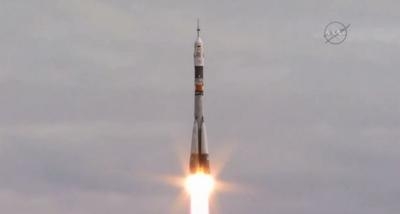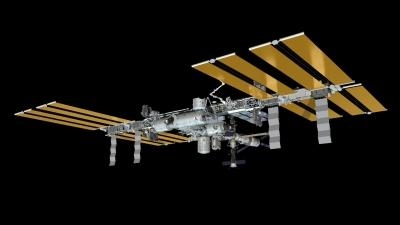Will Provide Return Transportation For One-Year Mission Team
Three crew members representing Russia, Denmark and Kazakhstan have launched to the International Space Station to provide a new ride home for the station’s one-year crew and continue important research that advances NASA's journey to Mars.

Sergey Volkov of Roscosmos, Andreas Mogensen of ESA (European Space Agency) and Aidyn Aimbetov of the Kazakh Space Agency launched aboard Soyuz TMA-18M from the Baikonur Cosmodrome in Kazakhstan at 12:37 a.m. EDT on Wednesday (10:37 a.m. in Baikonur). They are set to dock to the station at 3:42 a.m. on Friday, Sept. 4.
Expedition 44 Commander Gennady Padalka of Roscomos will hand over command of the space station to Expedition 44 Flight Engineer Scott Kelly of NASA on Saturday. Expedition 45 begins on Sept. 11 when Padalka, Mogensen and Aimbetov undock from the orbital outpost in the Soyuz spacecraft designated TMA-16M and return to Earth. The Soyuz TMA-16M carried Padalka, Kelly, and Roscosmos’ Mikhail Kornienko to space in March. Because each Soyuz remains in orbit for about six months, the spacecraft swap is necessary at the midway point of the one-year mission.
With the arrival of Volkov, Mogensen and Aimbetov, nine people will be aboard the orbiting laboratory for the first time since 2013. The three join Expedition 44 Flight Engineers Kelly and Kjell Lindgren of NASA, Commander Padalka and Flight Engineers Oleg Kononenko and Kornienko of Roscosmos, and Kimiya Yui of the Japan Aerospace Exploration Agency (JAXA).
On Tuesday, Sept. 15, Kelly and Kornienko will reach the halfway point of their one-year mission to advance understanding of the medical and psychological challenges astronauts face during long duration spaceflight, in addition to developing countermeasures that will help minimize adverse effects. The pair will spend 342 consecutive days living in space before returning to Earth with Volkov in March 2016 aboard the Soyuz TMA-18M.
In the coming months, Expedition 45 crew members will conduct more than 250 science investigations in fields such as biology, Earth science, human research, physical sciences, and technology development.

The recently installed CALorimetric Electron Telescope (CALET) searches for dark matter, measures cosmic rays and observes sources of high-energy phenomena in the galaxy. CALET seeks answers for several unknowns, including the origin of cosmic rays, how cosmic rays accelerate and move across the galaxy, and the existence of dark matter and its relation to nearby cosmic ray sources. Once scientists take an inventory of the highest-energy radiation in space, they may be able to characterize the radiation environment experienced by humans and encountered by space electronics. This may help determine risk of exposure to this type of radiation.
Ongoing station research also includes the Flame Extinguishment Experiment-2 JAXA (FLEX-2J), a study of combustion in microgravity. Fires burn differently in space, where fuels form spherical droplets and flames burn in a globular shape rather than teardrop. The crew studies the interactions of flames on the motion and ignition, or non-ignition, of millimeter-sized droplets. Results could provide key insights and improve computer modeling of fuel combustion to aid in reducing emissions and improving fuel efficiency in space and on Earth.
During the second half of the marathon one-year mission, the team will continue a wide variety of human research studies, such as the Assessing Telomere Lengths and Telomerase Activity in Astronauts (Telomeres). Telomeres are "caps" on the ends of chromosomes that protect them from fraying, much like the aglet on the end of a shoelace. Telomeres shorten over time, and the rate at which this occurs can be increased by stress, leading to accelerated aging, cardiovascular disease, cancer and an impaired immune system. The Telomeres investigation uses crew member blood samples to examine how telomeres and telomerase, an enzyme that maintains the length of telomeres, are affected by space travel and to better evaluate the impact of future spaceflight.
The International Space Station is a convergence of science, technology and human innovation that enables us to demonstrate new technologies and make research breakthroughs not possible on Earth. It has been continuously occupied since November 2000 and, since then, has been visited by more than 200 people and a variety of international and commercial spacecraft. The space station remains the springboard to NASA's next giant leap in exploration, including future missions to an asteroid and Mars.
(Images provided by NASA)
 NTSB Final Report: Aviat A1
NTSB Final Report: Aviat A1 ANN's Daily Aero-Linx (07.08.25)
ANN's Daily Aero-Linx (07.08.25) Classic Aero-TV: Fly Corvairs Reliable Engine Alternative
Classic Aero-TV: Fly Corvairs Reliable Engine Alternative ANN FAQ: Contributing To Aero-TV
ANN FAQ: Contributing To Aero-TV Classic Aero-TV: CiES Fuel-Quantity and e-Throttle Systems Praised
Classic Aero-TV: CiES Fuel-Quantity and e-Throttle Systems Praised




